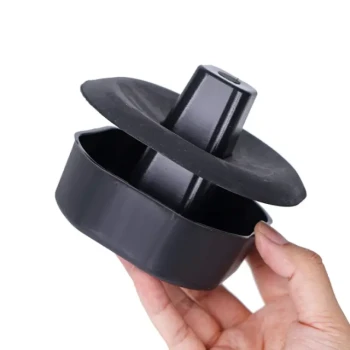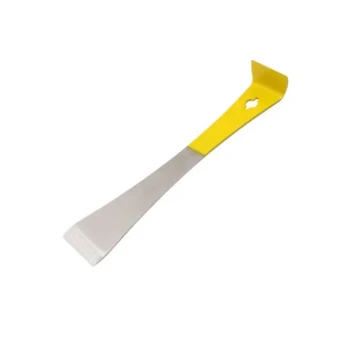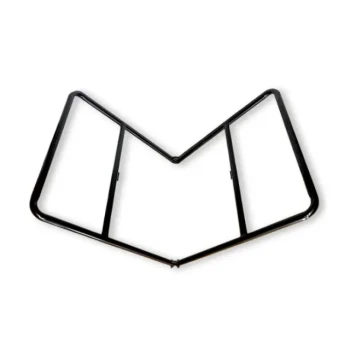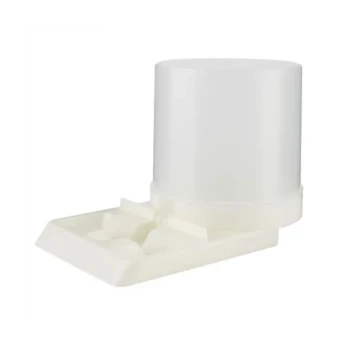At its most basic, your beehive should be placed on a dedicated hive stand, which can be as simple as a pair of cinder blocks or as specific as a commercially-built metal or wooden rack. This elevation is critical for protecting the colony from ground moisture, pests, and rot, while also making inspections easier on your back.
The physical stand your hive rests on is only one part of the equation. The hive's success is far more dependent on its overall location—a site chosen for proper sun exposure, drainage, safety, and protection from the elements.
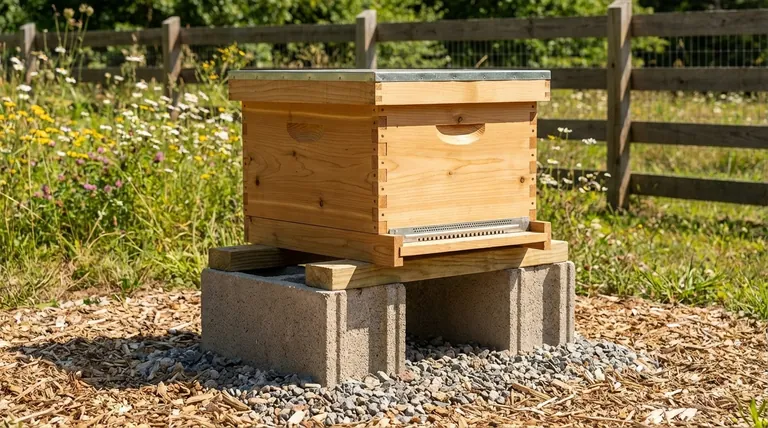
The Foundation: Preparing the Ground
Before you even place a stand, preparing the ground underneath is a crucial first step that many new beekeepers overlook. This preparation directly impacts hive health.
Why Ground Prep Matters
An unprepared patch of ground invites moisture, which can seep into the wood and chill the colony. It also provides a perfect breeding ground for pests, most notably the Small Hive Beetle (SHB), whose larvae pupate in the soil directly beneath the hive.
Effective Ground Cover Options
Clearing the area of grass and weeds is essential. To further inhibit pests and control moisture, place a barrier directly on the soil.
Options include a thick layer of gravel or wood chips, a piece of heavy-duty landscape plastic, or a permanent concrete paver or pad. Each of these creates an inhospitable environment for beetle larvae and prevents weed growth.
Choosing the Right Hive Stand
The stand itself serves three primary purposes: elevation, stability, and ergonomics.
The Purpose of Elevation
Lifting the hive off the ground improves air circulation, which is vital for preventing dampness and disease. It also creates a significant barrier for crawling pests like ants and reduces the chance of small animals (like skunks) disturbing the hive entrance.
Common Stand Options
Your choice of stand depends on budget and preference.
- Cinder Blocks: The most common and cost-effective solution. Two blocks provide a stable, rot-proof base.
- Wooden Stands: These can be easily built yourself or purchased. They are aesthetically pleasing but should be made from weather-resistant wood.
- Commercial Metal Stands: Often made of steel, these are incredibly durable and frequently include helpful features like frame holders to assist during inspections.
Ideal Height
A height of 12 to 18 inches is generally considered ideal. This is high enough to gain the benefits of elevation while still being low enough to allow you to safely lift heavy honey-filled boxes (supers) onto the top of the hive.
Critical Siting Factors Beyond the Stand
Where you place your stand is more important than what the stand is made of. The following environmental factors are non-negotiable for a thriving colony.
Sunlight and Orientation
Position your hive to receive morning sun. This warms the hive early, encouraging the bees to begin foraging sooner. If you live in a hot climate, some dappled afternoon shade can be beneficial to prevent overheating.
Accessibility and Flight Path
Ensure you have 24/7 access to your hive from the back or sides. The bees will establish a direct flight path from the entrance; you do not want to be in it. The hive entrance should have at least 20 feet of unobstructed clearance.
Protection from the Elements
Hives should be sheltered from strong, prevailing winds. A natural windbreak, like a line of trees, a hedge, or a fence, is ideal. This reduces stress on the colony as they work to maintain the hive's internal temperature.
Proximity to People and Water
For safety, locate the hive at least 100 feet from high-traffic areas like paths, patios, or neighboring properties. Bees also need a reliable water source nearby, such as a birdbath with stones in it for safe landing.
A Level Surface
The ground beneath your stand must be level. A tilted hive can cause the bees to build their comb incorrectly, making inspections difficult and potentially compromising the hive's structural integrity.
Understanding the Trade-offs
The "perfect" hive location is rare. Success often comes from balancing these ideals with the practical limitations of your space.
The Perfect Site vs. The Practical Site
You may not have a spot with perfect morning sun, a natural windbreak, and ideal clearance. Prioritize the most critical factors: a level, dry foundation and safety for people and pets. The bees are adaptable and can thrive even in locations that aren't textbook-perfect.
Stand Height vs. Ergonomics
A higher stand (24+ inches) offers superior protection from pests and moisture. However, it makes lifting heavy supers much more difficult and strenuous. A lower stand (12 inches) is easier to work with but requires more diligent ground preparation.
Sun vs. Shade
While morning sun is critical, all-day sun in a very hot climate can force the bees to spend excessive energy cooling the hive instead of foraging. If you must choose, favor sun over shade, but be prepared to provide ventilation or artificial shade during heatwaves.
Making the Right Choice for Your Goal
Select your hive's foundation based on your primary objectives as a beekeeper.
- If your primary focus is maximizing bee health and productivity: Prioritize a dry, pest-free ground covering and a location with morning sun and a windbreak.
- If your primary focus is beekeeper convenience and safety: Choose a stand at a comfortable working height and ensure the location has easy access and is far from human activity.
- If your primary focus is a simple, low-cost setup: A pair of level cinder blocks on cleared ground is a reliable, effective, and budget-friendly foundation.
By focusing on the hive's environment first, you are setting the stage for a healthy and productive colony.
Summary Table:
| Factor | Key Consideration | Ideal Choice |
|---|---|---|
| Ground Preparation | Moisture & Pest Control | Gravel, landscape plastic, or pavers |
| Hive Stand Height | Ergonomics & Protection | 12 to 18 inches |
| Stand Material | Durability & Cost | Cinder blocks, wood, or metal |
| Location - Sun | Foraging & Temperature | Morning sun, some afternoon shade in hot climates |
| Location - Wind | Colony Stress | Sheltered by a natural windbreak |
Ready to build a strong foundation for your apiary?
As a commercial beekeeper or equipment distributor, the right setup is critical for the health of your colonies and the efficiency of your operation. HONESTBEE supplies durable, wholesale-focused beekeeping supplies and equipment—from commercial-grade hive stands to essential tools—designed to support your success.
Let our experts help you choose the best equipment for your specific needs. Contact HONESTBEE today for wholesale pricing and expert advice.
Visual Guide
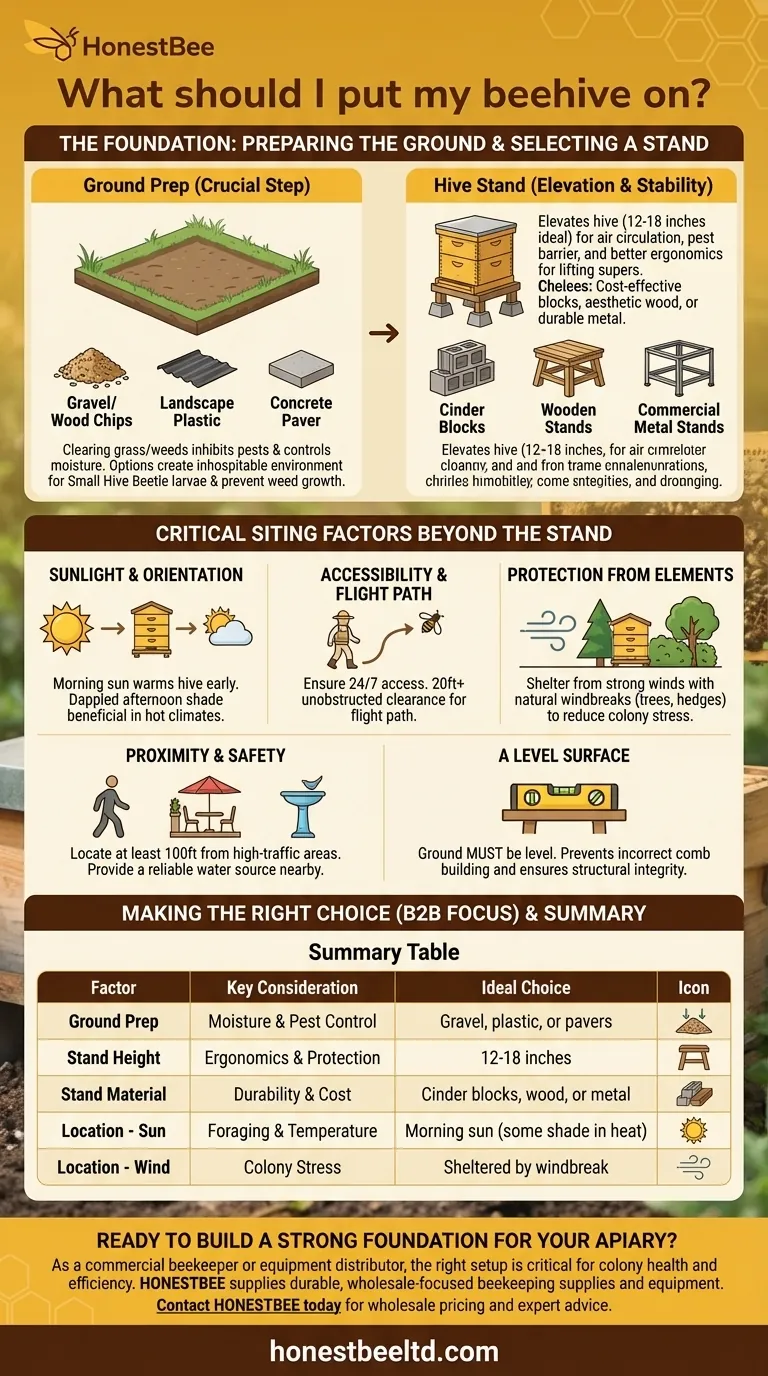
Related Products
- Professional Engraved Round Hive Number Tags for Beekeeping
- Professional Ant-Proof Beehive Stand with Integrated Moat for Beekeeping
- Wholesales Dadant Size Wooden Bee Hives for Beekeeping
- HONESTBEE Professional Long Handled Hive Tool with Precision Cutting Blade
- Professional Galvanized Hive Strap with Secure Locking Buckle for Beekeeping
People Also Ask
- What are the characteristics of Posca pens for marking queens? A Safe, Durable Solution for Hive Management
- Do I need a hive stand? Essential for Bee Health & Easier Beekeeping
- What maintenance is required for hive straps? A Guide to Cam Buckle vs. Ratchet Strap Care
- What is the best height for a hive stand? Optimize for Pest Control and Beekeeper Ergonomics
- Why should beekeepers consider using hive stands? Protect Your Hives and Your Back

